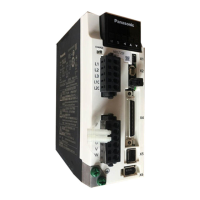Defines the filter frequency 1 against the velocity control output.
Torque compensation is enabled when the relation between Pr.
6.74 "Torque compensation frequency 1" and Pr. 6.75 "Torque
compensation frequency 2" satisfies the following formula.
1.0 Hz ≤ Pr. 6.75 ≤ Pr. 6.74 ≤ (Pr. 6.75 x 32)
Defines the filter frequency 2 against the velocity control output.
Torque compensation is enabled when the relation between Pr.
6.74 “Torque compensation frequency 1” and Pr. 6.75 “Torque
compensation frequency 2” satisfies the following formula.
1.0 Hz ≤ Pr. 6.75 ≤ Pr. 6.74 ≤ (Pr. 6.75 x 32)
How to use
There are two methods below for adjusting the load variation suppression function.
Disturbance suppression setting (No load inertia variation)
< Basic adjustment >
1. Make normal gain adjustment in advance.
Use real-time auto tuning (Pr. 0.02=1) with the load variation suppression function automatic
adjustment disabled (Pr. 6.10 bit14=0), and set stiffness (Pr. 0.03) as high as possible.
2. Set bit14 to 1 in Pr. 6.10 "Function expansion setup" to enable the load variation
suppression function automatic adjustment. As a result, Pr6.10 bit1 becomes 1.
And check disturbance suppression effect with the motor rotate.
- This Pr6.10 bit1 and 2 it will be 1.
- Before enabling or disabling the load variation suppression function, turn servo-off first.
- If this change causes the motor to oscillate or generates an abnormal sound, return to
Step 1. and decrease the servo rigidity by one or two levels before repeating the
subsequent steps.
< If further adjustment >
3. Set bit14 to 0 in Pr. 6.10 to disable the automatic adjustment of load variation suppression
function.
4. Specify a small value as possible in Pr. 6.24 “Load change compensation filter”.
Decreasing the filter setup value within the range that does not produce any significant abnormal
sound or torque command variation will improve disturbance suppression performance and
reduce motor velocity variation and encoder position deviation.
- When an abnormal sound at high frequency (1 kHz or above) is generated, increase the
value in Pr. 6.76 “Load estimation count. ”
- When vibration at low frequency (10 Hz or below) is produced after operation stops,
increase the value in Pr. 6.23 “Load change compensation gain”.
- No change is required for Pr. 6.73 "Load estimation filter" in normal cases, but you can
set the optimum point by fine-tuning within the range between around 0.00 and 0.20 ms.

